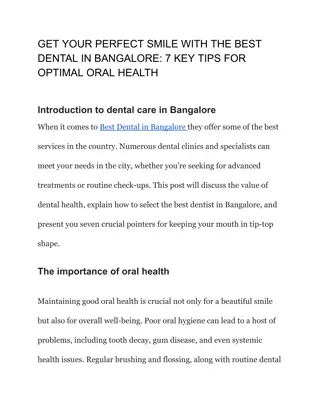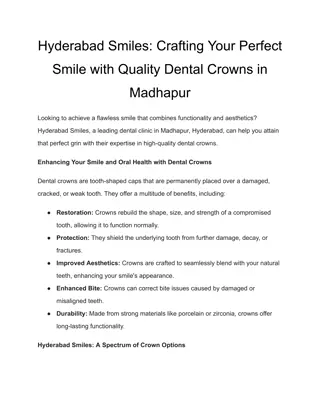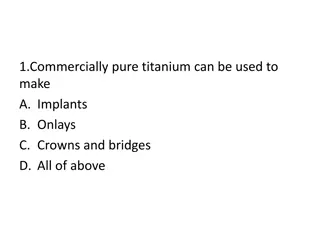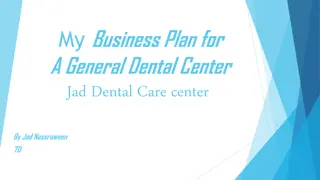Dental Terminology Overview for Beginners
Explore essential dental terms including abrasion, abutment, anesthesia, arch, bicuspid, bleaching, calculus, caries, cavity, and cementum. Enhance your understanding of oral health procedures and terminology commonly used in dentistry.
Download Presentation

Please find below an Image/Link to download the presentation.
The content on the website is provided AS IS for your information and personal use only. It may not be sold, licensed, or shared on other websites without obtaining consent from the author.If you encounter any issues during the download, it is possible that the publisher has removed the file from their server.
You are allowed to download the files provided on this website for personal or commercial use, subject to the condition that they are used lawfully. All files are the property of their respective owners.
The content on the website is provided AS IS for your information and personal use only. It may not be sold, licensed, or shared on other websites without obtaining consent from the author.
E N D
Presentation Transcript
General Dental Terminalogy Vocational English-I 08.10.2020
Abrasion a nma Tooth wear caused by forces other than chewing such as holding objects between the teeth or improper brushing. Abutment dayanak A tooth (or implant) that supports a dental prosthesis.
Anesthesia (uyu ma) A controlled state of unconsciousness, accompanied by a partial or complete loss of protective reflexes Apicoectomy (apikal rezeksiyon) Removal of the tip of a tooth root.
Arch (ark) Term used to refer to an upper or lower denture. Basic Cleaning (ana temizlik) Basic or routine cleaning for a normal amount of plaque build-up. Preventive treatment for patients with healthy gum tissue, not intended for patients with past history of or current gum disease.
Bicuspid (k k az di i) A premolar tooth; a tooth with two cusps. Bilateral (ikili) Occurring on, or pertaining to, both right and left sides. Biopsy (biyopsi) Process of removing tissue for histologic evaluation.
Bleaching (beyazlatma) A cosmetic dental procedure that whitens the teeth using a bleaching solution. Bonding (Yap t rma, birle tirme) A composite resin applied to a tooth to change its shape and/or color. Bonding also refers to how a filling, orthodontic appliance or some fixed partial dentures are attached to teeth.
Calculus (di ta ) Hard deposit of mineralized material adhering to crowns and/or roots of teeth. Caries (di r ) Commonly used term for tooth decay.
Cavity ( r k,oyuk) Decay in tooth caused by caries; also referred to as carious lesion. Cementum (di k k n saran kemiksi doku) Hard connective tissue covering the tooth root.
Composite (bile im) A dental restorative material made up of disparate or separate parts (e.g., resin and quartz particles). Crown (kaplama) Simple crown procedure utilizing a porcelain crown fused to non-precious metal and not involving complicated prep.
Cusp (sivri u ) The pointed portion of the tooth. Decay ( r k) The lay term for carious lesions in a tooth; decomposition of tooth structure. Dental Prophylaxis (di profilaksisi) Scaling and polishing procedure performed to remove coronal plaque, calculus, and stains.
Dental Prosthesis (di protezi) An artificial device that replaces one or more missing teeth. Dental Specialist (uzman) A dentist who has received postgraduate training in one of the recognized dental specialties.
DDS (di cerrah ) Doctor of Dental Surgery DMD (di doktoru) Doctor of Dental Medicine Dentin (di kemi i) The part of the tooth that is beneath the enamel and cementum.
Denture (protez di ) An artificial substitute for natural teeth and adjacent tissues Dry Mouth (kuru a z) The condition of not having enough saliva to keep the mouth wet. If it goes untreated, severe dry mouth can lead to increased levels of tooth decay and infections of the mouth.
Enamel (Di in ta k sm n rten sar ms beyaz, parlak, sert tabaka) Hard calcified tissue covering dentin of the crown of tooth. Endodontist (kanal tedavi uzman ) A dental specialist who limits his/her practice to treating disease and injuries of the pulp and associated periradicular conditions.
Erosion (a nma) Wearing down of tooth structure, caused by chemicals (acids). Excision (kesip karma) Surgical removal of bone or tissue. Extraction (di ekme) The process or act of removing a tooth or tooth parts.
Fracture (k r k) The breaking of a part, especially of a bony structure; breaking of a tooth. Gingiva (di eti) Soft tissues overlying the crowns of unerupted teeth and encircling the necks of those that have erupted.
Impacted Tooth (g m l di ) An unerupted or partially erupted tooth that is positioned against another tooth, bone, or soft tissue, so that complete eruption is unlikely. Implant (yerle tirmek (protez vb)) Material inserted or grafted into tissue.
Interproximal (di aras ) Between the teeth. Intraoral (a z i i) Inside the mouth. Jaw ( ene) A common name for either the maxilla or the mandible.
Labial (duda a ili kin) Pertaining to or around the lip. Lesion (lezyon) An injury or wound; area of diseased tissue. Maxilla ( st ene) The upper jaw.
Molar (az di i) Teeth posterior to the premolars (bicuspids) on either side of the jaw; grinding teeth, having large crowns and broad chewing surfaces. Occlusal ( s rma) Pertaining to the biting surfaces of the premolar and molar teeth or contacting surfaces of opposing teeth or opposing occlusion rims.
Orthodontist (di d zeltim uzman ) A dental specialist whose practice is limited to the interception and treatment of malocclusion of the teeth and their surrounding structures. Overdenture (takma di ) A removable prosthetic device that overlies and may be supported by retained tooth roots or implants.
Palate (damak) The hard and soft tissues forming the roof of the mouth that separates the oral and nasal cavities. Periodontal (di etlerine ili kin) Pertaining to the supporting and surrounding tissues of the teeth.
Pulp (di z ) Connective tissue containing blood vessels and nerve tissue which occupies the pulp cavity of a tooth. Reline (yeniden d zenlemek) To resurface the side of the denture that is in contact with the soft tissues of the mouth to make it fit more securely.
Fracture (k r k) The breaking of a part, especially of a bony structure; breaking of a tooth. Gingiva (di eti) Soft tissues overlying the crowns of unerupted teeth and encircling the necks of those that have erupted.
Root (k k) The anatomic portion of the tooth that is covered by cementum and is located in the alveolus (socket) where it is attached by the periodontal apparatus; radicular portion of tooth. Veneer (kaplama) In the construction of crowns or pontics, a layer of tooth-colored material usually, but not limited to, composite, porcelain, ceramic or acrylic resin, attached to the surface by direct fusion, cementation, or mechanical retention; also refers to a restoration that is luted to the facial surface of a tooth.























